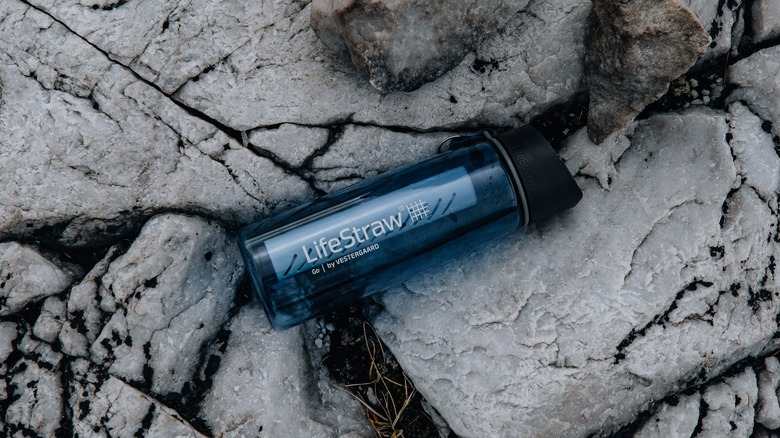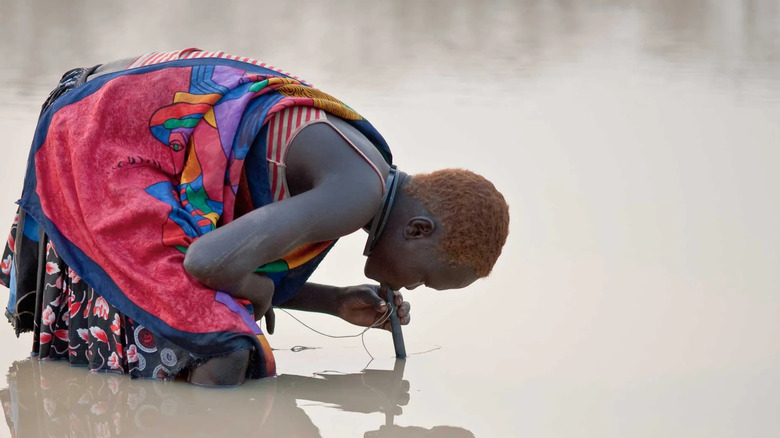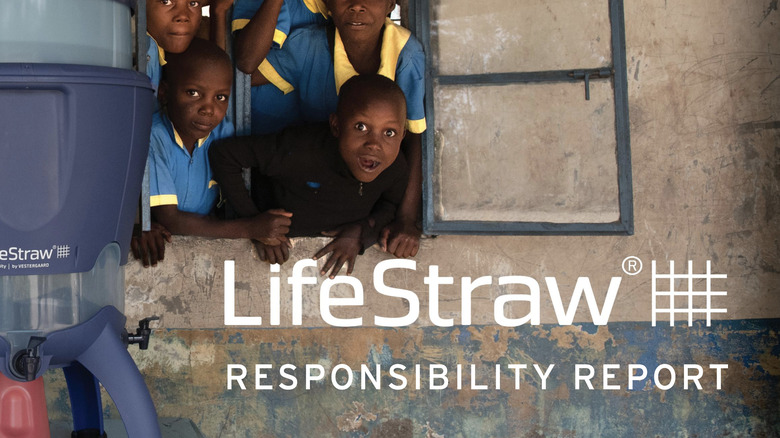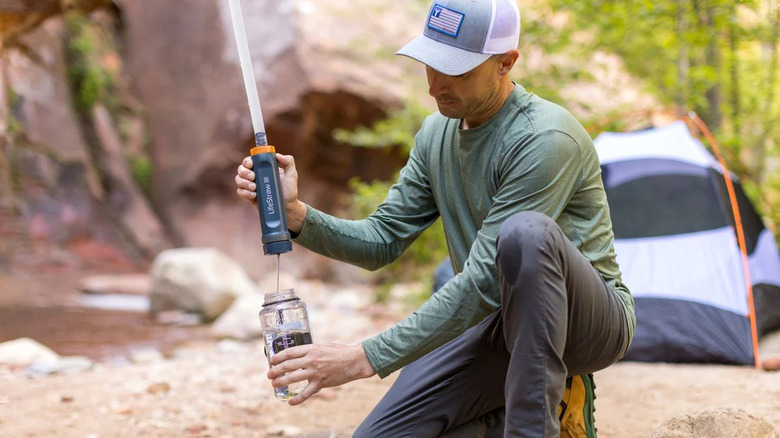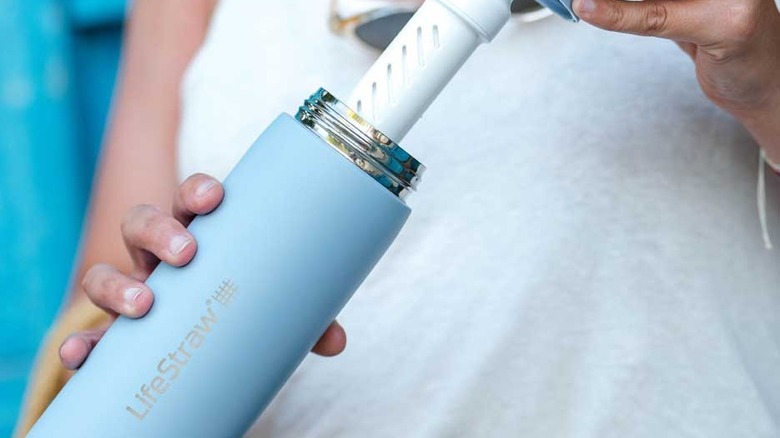How Good Is LifeStraw And Is It Worth It For Your Next Camping Trip?
While many beautiful things come with camping, having limited access to clean water is not one of them. For adventurous spirits, finding new campgrounds and staying in remote areas can be thrilling, but the price you have to pay is possible exposure to contaminated water.
According to the Centers for Disease Control and Prevention (CDC), ingesting contaminated water can lead to diarrhea, vomiting, and stomach pain. Whether for drinking, cooking, or brushing teeth, it's always important to be cautious about what we let into our bodies. Despite looking clean, unfiltered water can contain a host of bacteria, chemicals, or even parasites, which can lead to temporary or long-term health issues.
In previous times, campers have resorted to things like boiling water or adding water-purifying chemicals like iodine. These days, brands like LifeStraw make it possible to filter a variety of risky contaminants to make water safe to ingest conveniently without adding additional risks. But what is LifeStraw, how does it work, and is it worth it for your next camping trip?
What is LifeStraw?
In 1999, Vestergaard created the initial prototype for LifeStraw to help filter out Guinea worm lava and prevent Guinea worm disease. Six years later, LifeStraw evolved to become an award-winning tool for providing potable water in humanitarian aid with its straw filter design. Using hollow fiber membrane technology, its microscopic holes filter out bacteria, parasites, dirt, and even microplastics. LifeStraw describes its technology as a "super advanced spaghetti strainer or tea sieve."
In its original design, the LifeStraw personal water filter ($19.95) was composed of ABS plastic, weighed 1.6 ounces, and was meant to last up to 1,000 gallons. For its straw filter model to work, you need to quite literally suck it and move water through its 0.2-micron pores. In 2013, LifeStraw released its first refillable water bottle, which targets the outdoor consumer market. Since then, it has expanded its product line to include bottle filters, dispenser filters, gravity filters, pitcher filters, and high-volume filters.
In 2022, it released an upgraded version of its original LifeStraw personal water filter called the LifeStraw Peak Series ($24.95) with improved filter technology and slightly heavier housing materials built for better durability.
Is LifeStraw good?
Although a pioneer in the personal water filter category, LifeStraw is no longer the most effective. The Sawyer Mini Water Filtration System is not only lighter at 1.4 ounces but also overall cheaper and better at filtering. Despite its slightly higher upfront price, the Sawyer Mini Water Filtration System ($22.98 at Walmart) can filter up to 0.1 microns and last for up to 100,000 gallons, which means you can use it 100 times more than the LifeStraw.
However, there are plenty of reasons why you may still want a LifeStraw, especially if you're big on sustainability. Because LifeStraw originated as a tool for humanitarian aid, the social and environmental impact remains heavily rooted in its DNA. In its annual Responsibility Report, you can learn more about LifeStraw's many projects, including its ongoing partnership with the Carter Foundation, wherein it has consistently helped supply potable water in West Africa through disaster and emergency response work. Not to mention, LifeStraw is also a Climate Neutral Certified brand, which shows its commitment to sustainability goes beyond just stopping people from using water bottles.
So, while LifeStraw may not be the best bang for your buck, its effective product, relatively affordable price-point, and commitment to its brand values may be reason enough for you to make a purchase. In fact, with its wide portfolio, it definitely gives campers a lot of options to choose from.
Is LifeStraw worth it for your next camping trip?
Obviously, if you're planning to go on a short, solo camping trip through a relatively dry trail, like a desert, it doesn't make sense to bring a LifeStraw personal water filter with you. After all, you're not expecting to be around any water to filter. In this scenario, you may just want to bring an ordinary reusable bottle instead.
But if you're going to do a camping trip in a designated park with flowing water sources, it makes more sense to carry a LifeStraw. With a LifeStraw Go Series ($49.95) bottle, you can even scoop up water from a stream or lake instead of bending down and drinking directly. That said, you may not like the cost of replacing the membrane microfilter ($24.95) or being unable to transfer the filtered water to your mobile coffee maker.
While LifeStraw's personal filter or Go Series bottles are great for single-person use, they don't let you store filtered water for later use. In addition, if you're camping with a pet or multiple people, a LifeStraw Flex with Gravity Bag ($54.95), which lets you fill up separate water bottles or even bowls for your pets, might be better.
If you're camping in a luxury van or with a large group, you may also want to consider more robust filtering methods that can handle higher volumes. Although, for shorter trips, the LifeStraw Gravity Filter with Virus Removal ($189.95) can be a good enough solution.
Tips for maximizing LifeStraw's use
It's important to remember that LifeStraw or any other portable water filter should be used to supplement access to clean water but not be a replacement. If it's possible to survive on the water you've brought from a trusted source, you should always opt for that instead. While the LifeStraw is good at its job, the quality of its filtering also depends on how long you've used it and how well you've maintained it.
Because of its limited lifespan, it's vital to regularly check if it's time to replace the unit or its filter. If not, you may accidentally consume water that is unsafe for your body. Often, the flow rate or speed at which the water is filtered can indicate whether it's time to replace it. In addition, it's best to avoid exposing your LifeStraw to harsh chemical detergents to avoid damaging the filter. When not in use, aside from rinsing its caps and accompanying accessories, LifeStraw recommends pushing around a solution of 1/4 teaspoon bleach and 1–2 cups water inside the filter before rinsing it with water.
Alternatively, you may also want to add other ways of disinfecting your water in an unfamiliar place, such as using iodine tablets. According to the National Library of Medicine, iodine is an effective, simple, and cost-efficient means of water disinfection. However, you should be mindful of doing this too often because it can lead to thyroid issues.
